Lybiidae – African Barbets
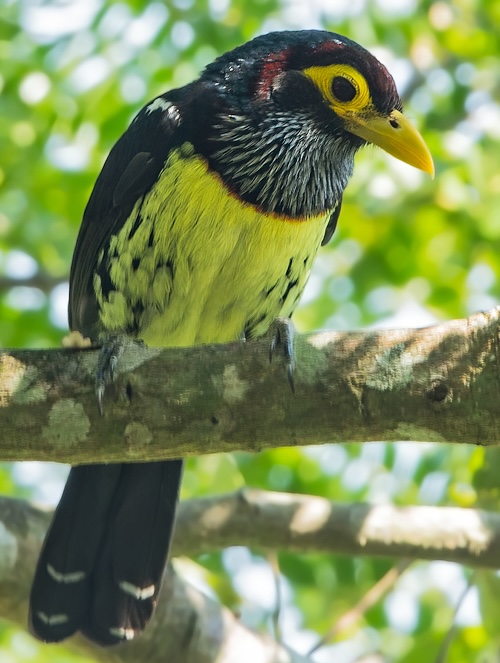
The Lybiidae or African barbets are a family of near passerine birds confined to Africa. They were usually united with their American and Asian relatives in the Capitonidae for quite some time. The species range from the type genus Lybius of forest interior to the Pogoniulus (tinkerbirds) of forest and scrubland. They are found throughout sub-Saharan Africa, with the exception of the far south-west of South Africa.
They form part of the order Piciformes, along with Megalaimidae (Asian Barbets), Capitonidae (New World Barbets), Ramphastidae (Toucans), Indicatoridae (Honeyguides) and Picidae (Woodpeckers). The African terrestrial barbets, Trachyphoninae, range from the southern Sahara to South Africa. Members of one genus, Trachyphonus, they are the most open-country species of barbets. The subfamily Lybiinae contains the African arboreal barbets.
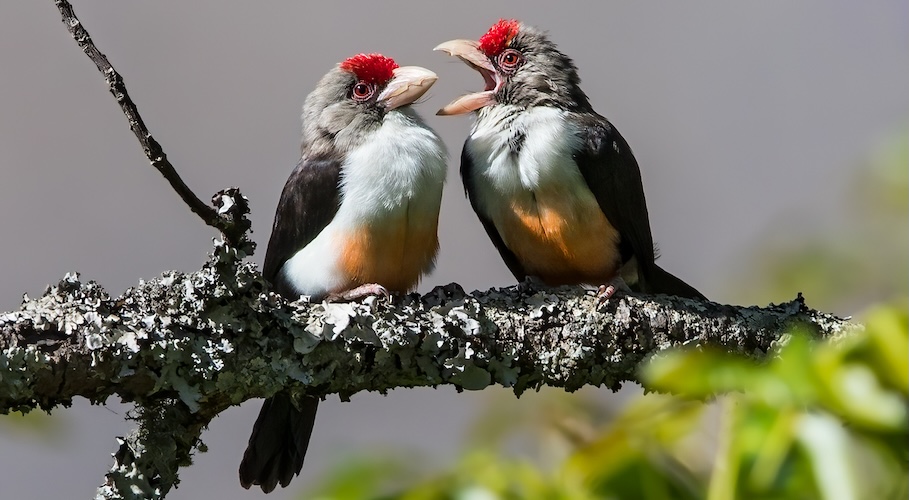
Black-backed Barbet Pogonornis minor – ©Dubi Shapiro
From the tiniest tinkerbird with a dainty bill to the largest Pogonornis barbet with a hefty toothed bill, this is the most morphologically diverse barbet family. Lybiids are also the most variable of the barbets in rictal bristle development and extent of facial feathering; some species have completely naked heads and in others the bills are almost totally obscured by a profusion of long, adpressed bristles. Lybiids include the only barbets to spend a great deal of time on the ground, and some that burrow into earthen banks to nest rather than using the tree cavities preferred by all other barbets.
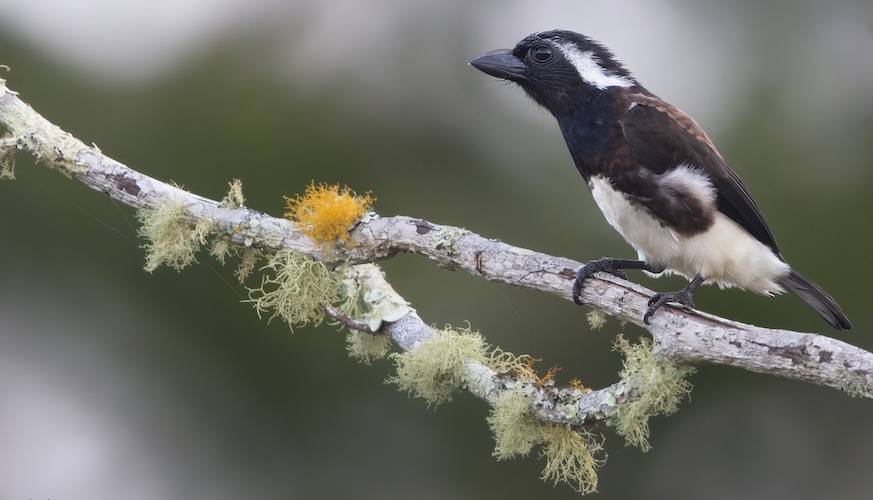
White-eared Barbet Stactolaema leucotis – ©Dubi Shapiro
Most African barbets are about 20cm to 25cm long, plump-looking, with large heads, and their heavy bill is fringed with bristles; the tinkerbirds are smaller, ranging down to the Red-rumped Tinkerbird at 7g and 9cm. They are mainly solitary birds, eating insects and fruit. Figs and numerous other species of fruiting tree and bush are visited, and an individual barbet may feed on as many as 60 different species in its range. They will also visit plantations and take cultivated fruit and vegetables. Fruit is eaten whole and indigestible material such as seed pits regurgitated later (often before singing).
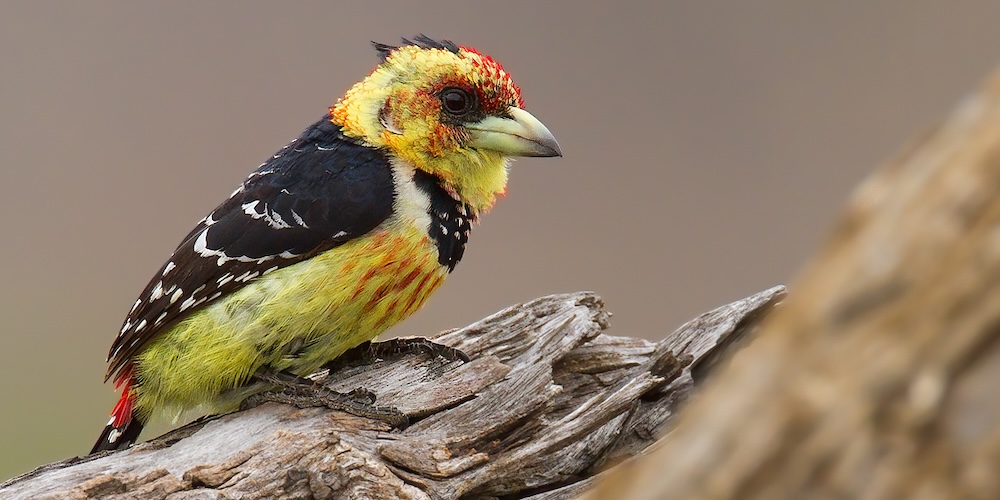
Crested Barbet Trachyphonus vaillantii – ©Dubi Shapiro
Regurgitation does not usually happen in the nest (as happens with toucans), although tinkerbirds do place sticky mistletoe seeds around the entrances of their nests, possibly to deter predators. As the other barbets, they are thought to be important agents in seed dispersal in tropical forests.
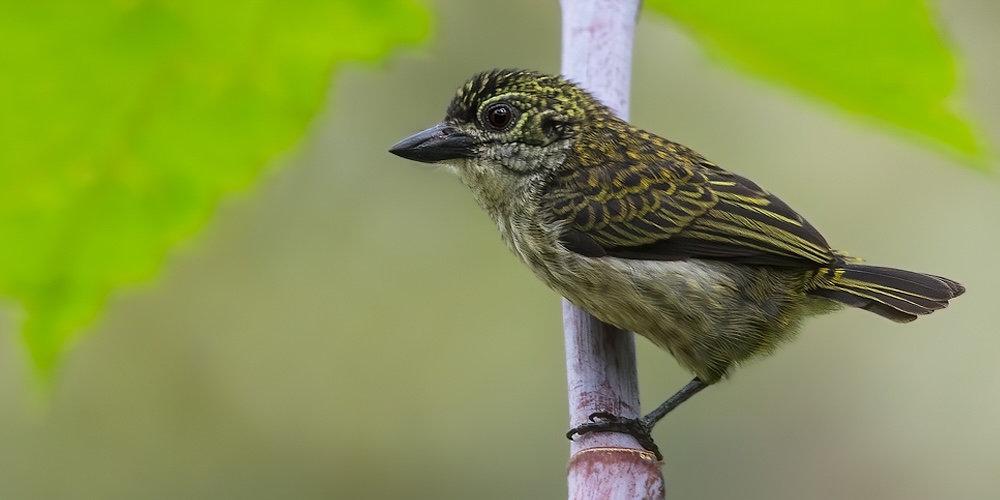
Speckled Tinkerbird Pogoniulus scolopaceus – ©Dubi Shapiro
As well as taking fruit, African barbets also take arthropod prey, gleaned from the branches and trunks of trees. A wide range of insects are taken, including ants, cicadas, dragonflies, crickets, locusts, beetles, moths and mantids. Scorpions and centipedes are also taken, and a few species will take small vertebrates such as lizards, frogs and geckos.

Northern Red-fronted Tinkerbird Pogoniulus uropygialis – ©Dubi Shapiro
The precise nesting details of many African barbets are not well known, although peculiarly among the Piciformes, some sociable species will nest in riverbanks or termite nests. Like many members of their order, Piciformes, their nests are in holes bored into a tree, and they usually lay between two and four eggs (except for the Yellow-breasted Barbet which lays up to six), incubated for thirteen to fifteen days. Nesting duties are shared by both parents.
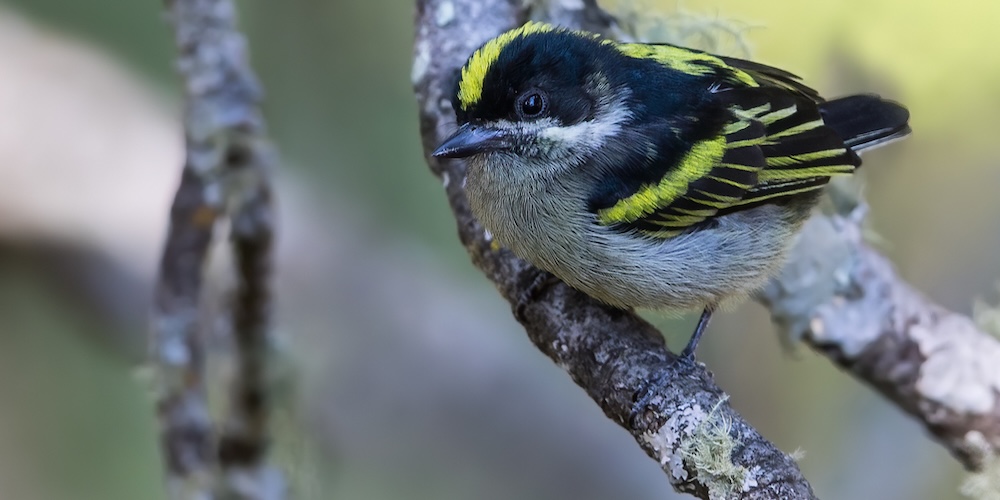
Western Green Tinkerbird Pogoniulus coryphaea – ©Dubi Shapiro
It is believed that African Barbets, or their close ancestors were found in pre-historic Europe. Supposed fossil remains of Late Miocene Pogoniulus were found at Kohfidisch (Austria), but have not yet been thoroughly studied. It is not clear whether they belong to the extant genus, but given the late date this may well be so.
-
Number of bird species: 43
(As at August 2025)
According to the recently (2025) combined AviList, there are 43 species of Lybiidae (African Barbets) in ten genera. They are:
Eastern Yellow-billed Barbet Trachylaemus purpuratus
Western Yellow-billed Barbet Trachylaemus goffinii
Crested Barbet Trachyphonus vaillantii
Red-and-yellow Barbet Trachyphonus erythrocephalus
Yellow-breasted Barbet Trachyphonus margaritatus
D’Arnaud’s Barbet Trachyphonus darnaudii
Green Barbet Cryptolybia olivacea
Yellow-spotted Barbet Buccanodon duchaillui
White-eared Barbet Stactolaema leucotis
Whyte’s Barbet Stactolaema whytii
Anchieta’s Barbet Stactolaema anchietae
Grey-throated Barbet Gymnobucco bonapartei
Sladen’s Barbet Gymnobucco sladeni
Bristle-nosed Barbet Gymnobucco peli
Naked-faced Barbet Gymnobucco calvus
Speckled Tinkerbird Pogoniulus scolopaceus
Eastern Green Tinkerbird Pogoniulus simplex
Moustached Tinkerbird Pogoniulus leucomystax
Western Green Tinkerbird Pogoniulus coryphaea
Red-rumped Tinkerbird Pogoniulus atroflavus
Yellow-throated Tinkerbird Pogoniulus subsulphureus
Yellow-rumped Tinkerbird Pogoniulus bilineatus
Northern Red-fronted Tinkerbird Pogoniulus uropygialis
Southern Red-fronted Tinkerbird Pogoniulus pusillus
Yellow-fronted Tinkerbird Pogoniulus chrysoconus
Hairy-breasted Barbet Tricholaema hirsuta
Red-fronted Barbet Tricholaema diademata
Miombo Pied Barbet Tricholaema frontata
Acacia Pied Barbet Tricholaema leucomelas
Spot-flanked Barbet Tricholaema lacrymosa
Black-throated Barbet Tricholaema melanocephala
Brown-breasted Barbet Pogonornis melanopterus
Black-backed Barbet Pogonornis minor
Double-toothed Barbet Pogonornis bidentatus
Bearded Barbet Pogonornis dubius
Black-breasted Barbet Pogonornis rolleti
Banded Barbet Lybius undatus
Vieillot’s Barbet Lybius vieilloti
White-headed Barbet Lybius leucocephalus
Chaplin’s Barbet Lybius chaplini
Red-faced Barbet Lybius rubrifacies
Black-billed Barbet Lybius guifsobalito
Black-collared Barbet Lybius torquatus
-
Toucans, Barbets and Honeyguides
| By Lester L Short, Jennifer FM Horne and Albert Earl Gilbert | OUP | 2001 | Hardback | 526 pages, 36 col plates, col photos, illus, maps | ISBN: 9780198546665 Buy this book from NHBS.com
-
Lybiidae
Family AccountLybiids include the only barbets to spend a great deal of time on the ground, and some species burrow into earthen banks to nest rather than using the tree... -
Lybiidae
Family AccountLybiidae is a family of birds also known as the African barbets. There are 44 species ranging from the type genus Lybius of forest interior to the tinkerbirds...
Given the number of species in this family, Fatbirder does not provide quick links to all of them. However, the entries below do include links to representatives of every genera, all those illustrated and some of the most often encountered, iconic or sought-after species.
-
Acacia Pied Barbet Tricholaema leucomelas
Species AccountThe acacia pied barbet or pied barbet (Tricholaema leucomelas) is a species of bird in the family Lybiidae which is native to southern Africa. -
Acacia Pied Barbet Tricholaema leucomelas
Species AccountSound archive and distribution map. -
Bearded Barbet Lybius dubius
Species AccountThe bearded barbet (Lybius dubius) is an African barbet. Barbets and toucans are a group of near passerine birds with a worldwide tropical distribution. The barbets get their name from the bristles which fringe their heavy bills. -
Bearded Barbet Lybius dubius
Species AccountSound archive and distribution map. -
Black-backed Barbet Pogonornis minor
Species AccountBlack-backed barbet (Pogonornis minor) is a species of bird in the Lybiidae family. It is found in Gabon, Angola, Zambia, Republic of the Congo and Democratic... -
Black-backed Barbet Pogonornis minor
Species AccountSound archive and distribution map. -
Black-collared Barbet Lybius torquatus
Species AccountThe black-collared barbet (Lybius torquatus) is a species of bird in the family Lybiidae which is native to sub-Saharan Africa. -
Black-collared Barbet Lybius torquatus
Species AccountSound archive and distribution map. -
Bristle-nosed Barbet Gymnobucco peli
Species AccountThe bristle-nosed barbet (Gymnobucco peli) is a bird species in the family Lybiidae. It used to be placed in the family Bucconidae... -
Bristle-nosed Barbet Gymnobucco peli
Species AccountSound archive and distribution map. -
Crested Barbet Trachyphonus vaillantii
Species AccountThe crested barbet (Trachyphonus vaillantii) ('trachys'=rough, 'phone'=voice, sound') is a sub-Saharan bird in the Lybiidae family. Its specific name commemorates François Levaillant, a famed French naturalist. -
Crested Barbet Trachyphonus vaillantii
Species AccountSound archive and distribution map. -
D'Arnaud's Barbet Trachyphonus darnaudii
Species AccountD'Arnaud's barbet (Trachyphonus darnaudii) is an African barbet. Barbets and toucans are a group of near passerine birds with a worldwide tropical distribution. The barbets get their name from the bristles which fringe their heavy bills. Four geographical races (darnaudii, böhmi, emini and usambiro) have been recorded. -
D'Arnaud's Barbet Trachyphonus darnaudii
Species AccountTrachyphonus darnaudii is listed as Least Concern. -
D'Arnaud's Barbet Trachyphonus darnaudii
Species AccountSound archive and distribution map. -
Eastern Yellow-billed Barbet Trachylaemus purpuratus
Species AccountA large brightly colored barbet of forests and forest edges. Distinctive with its bright yellow bill and eye ring, dark head, back, and tail, and bright yellow belly with dark patches along the sides. -
Eastern Yellow-billed Barbet Trachylaemus purpuratus
Species AccountSound archive and distribution map. -
Green Barbet Cryptolybia olivacea
Species AccountThe green barbet (Cryptolybia olivacea) is a species of bird in the Lybiidae family (African barbets). It is found in Kenya, Tanzania, Malawi, Mozambique and... -
Green Barbet Cryptolybia olivacea
Species AccountSound archive and distribution map. -
Northern Red-fronted Tinkerbird Pogoniulus uropygialis
Species AccountThe northern red-fronted tinkerbird (Pogoniulus uropygialis) is a small bird in the African barbet family Lybiidae that is found in East Africa. -
Northern Red-fronted Tinkerbird Pogoniulus uropygialis
Species AccountSound archive and distribution map. -
Speckled Tinkerbird Pogoniulus scolopaceus
Species AccountA distinctive, large-billed tinkerbird of forest and forest edge, yellow-green below and olive-green above with streaked underparts and scalloped upperparts... -
Speckled Tinkerbird Pogoniulus scolopaceus
Species AccountSound archive and distribution map. -
Spot-flanked Barbet Tricholaema lacrymosa
Species AccountThe spot-flanked barbet (Tricholaema lacrymosa) is a species of bird in the family Lybiidae. It is found in Burundi, Democratic Republic of the Congo, Kenya... -
Spot-flanked Barbet Tricholaema lacrymosa
Species AccountSound archive and distribution map. -
Western Green Tinkerbird Pogoniulus coryphaea
Species AccountDark and distinctive little tinkerbird. There is a yellow stripe along the back from the crown to the rump, a white moustache stripe, and strong yellow marks... -
Western Green Tinkerbird Pogoniulus coryphaea
Species AccountSound archive and distribution map. -
White-eared Barbet Stactolaema leucotis
Species AccountSmall and distinctive dark-brown-and-white barbet. The amount of white on the face varies geographically, but there is always a white stripe behind the eye. -
White-eared Barbet Stactolaema leucotis
Species AccountSound archive and distribution map. -
Yellow-breasted Barbet Trachyphonus margaritatus
Species AccountThe yellow-breasted barbet (Trachyphonus margaritatus) is a species of bird in the Lybiidae family. It is found in Burkina Faso, Chad, Djibouti, Eritrea, Ethiopia, Mali, Mauritania, Niger, Nigeria, Somalia, and Sudan. -
Yellow-breasted Barbet Trachyphonus margaritatus
Species AccountTrachyphonus margaritatus is listed as Least Concern. -
Yellow-breasted Barbet Trachyphonus margaritatus
Species AccountSound archive and distribution map. -
Yellow-spotted Barbet Buccanodon duchaillui
Species AccountThe yellow-spotted barbet (Buccanodon duchaillui) is a bird species in the monotypic genus Buccanodon. It belongs to the African barbet family (Lybiidae)... -
Yellow-spotted Barbet Buccanodon duchaillui
Species AccountSound archive and distribution map.
